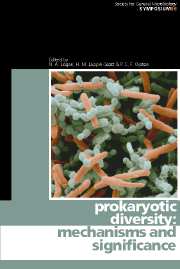Book contents
- Frontmatter
- Contents
- Contributors
- Editors' Preface
- Microbial diversity in the era of genomics
- Patterns in prokaryotic biodiversity
- A putative RNA-interference-based immune system in prokaryotes: the epitome of prokaryotic genomic diversity
- The significance of prokaryote diversity in the human gastrointestinal tract
- The genetics of phenotypic innovation
- Minimal genomes required for life
- Evolution of the core of genes
- Biogeographical diversity of archaeal viruses
- Is there a link between Chlamydia and heart disease?
- Unculturable oral bacteria
- Comparative genomics – what do such studies tell us about the emergence and spread of key pathogens?
- Spread of genomic islands between clinical and environmental strains
- Evolving gene clusters in soil bacteria
- Unusual micro-organisms from unusual habitats: hypersaline environments
- Genomic islands and evolution of catabolic pathways
- Horizontal gene transfer and its role in the emergence of new phenotypes
- Index
Microbial diversity in the era of genomics
Published online by Cambridge University Press: 06 July 2010
- Frontmatter
- Contents
- Contributors
- Editors' Preface
- Microbial diversity in the era of genomics
- Patterns in prokaryotic biodiversity
- A putative RNA-interference-based immune system in prokaryotes: the epitome of prokaryotic genomic diversity
- The significance of prokaryote diversity in the human gastrointestinal tract
- The genetics of phenotypic innovation
- Minimal genomes required for life
- Evolution of the core of genes
- Biogeographical diversity of archaeal viruses
- Is there a link between Chlamydia and heart disease?
- Unculturable oral bacteria
- Comparative genomics – what do such studies tell us about the emergence and spread of key pathogens?
- Spread of genomic islands between clinical and environmental strains
- Evolving gene clusters in soil bacteria
- Unusual micro-organisms from unusual habitats: hypersaline environments
- Genomic islands and evolution of catabolic pathways
- Horizontal gene transfer and its role in the emergence of new phenotypes
- Index
Summary
THE CONTINUING SAGA OF THE MICROBIAL SPECIES
Fundamental to the assessment of global microbial diversity is understanding the unit of measurement of diversity, namely the microbial species. Historically, definition of a microbial species has been accomplished by employing relatively crude methods based on laboratory culture. Limitations of both the methods and the philosophical construct underpinning the species definition for micro-organisms have been elaborately detailed by Woese (2004), who pointed out the fallacies of the ‘concept of a bacterium’ that led to the inclusion of all bacteria (as then understood) within the single grouping of ‘prokaryotes’, with a shared ‘prokaryotic’ organization evolved ultimately from a common prokaryotic ancestor (Stanier & van Niel, 1962; Stanier et al., 1957, 1963). Woese (2004) tracks the history of the ‘prokaryote–eukaryote’ dichotomy to the protozoologist Edouard Chatton (1938), whose reasoning was that, just as nucleated cells represented a monolithic grouping structurally and phylogenetically, non-nucleated cells (bacteria) also do so. Woese (2004) provides an eloquent explanation for the lack of philosophical understanding impelled by, on the one hand, technological advance and, on the other, ‘fundamentalist reductionism’ (the reductionism of 19th century classical physics), namely the view that living systems can be completely understood in terms of the properties of their constituent parts. The unfortunate aspect of fundamentalist reductionism is that it ignores the notion of emergent properties. The definition of a ‘micro-organism’ is, in itself, elusive.
- Type
- Chapter
- Information
- Prokaryotic DiversityMechanisms and Significance, pp. 1 - 18Publisher: Cambridge University PressPrint publication year: 2006



